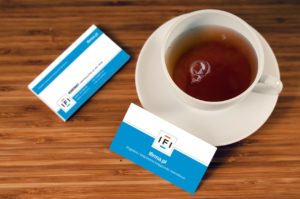What Information Should You Put on Your Business Card?
A business card is not just an instrument for giving your information out to leads but can be an opportunity to connect with new prospects on a more personal level. Good business cards will never be substituted by any digital networking platform, because digital tools sometimes lack the human factor of the equation. It is an extension of your brand that bears information about who you are and what you do in a notable, influential, and meaningful way.
A typical business card is 3.5 inches by 2 inches, and mini business cards are 2.75 inches by 1.125 inches. Although some of these are optional, at a minimum a business card should contain:
1. Logo and Tagline
Your logo and tagline are very important. As an extension of your business, your business card needs to carry your business identity (through the shapes, colors, and words it features) to leads.
2. Name and Job Title
You’d be surprised how many individuals get this wrong. First the name. Introduce yourself as you like to be called to avoid awkward re-introductions later. If you wear many hats in your business, decide which one you should note on your business cards. Use the one that describes your main function in the business—where function means the work prospects may hire you to do.
3. Contact Information
Contact information is the meat of a business card. If you want people to reach out, you have to tell them how. But which contact info should you include? The key word to keep in mind is “direct.” Create a personal connection between you and prospects and don’t break that connection by providing them with a generic email or a general phone line where they have to go through a digital menu and three operators.
However, you don’t want to give your home phone number where your young kid might answer the phone, or your personal email address. Also, only include your physical address if you have a shop or studio whose physical location is crucial to doing business.
4. Your Website, But Not Your Homepage
Create a page with a warm message so people get to know you better and understand how you can help them. Put a special offer on there for them or a downloadable item as a thank you for connecting. In short, send prospects to a page that ultimately deepens the connection you’ve created with them in person. One more tip: Make the URL something short and easy to type.
5. Social Media Profiles
Social media profiles have become indispensable parts of both traditional and virtual businesses. Include your social media profiles on your business card. But not all of them. Choose well which ones to include. If you’re a photographer or producer who is active on Instagram, list it. If you’re a graphic designer with clout on Behance, you should send people there. If you own a small business with a strong textual presence and following on channels like Medium, promote that.
6. Creativity
This final tip is the holy grail of business card designs. All the tips above fall under the category of practical advice for best results. Show people what you do through your card design rather than simply tell them through your job title. Make them laugh, intrigue them, let them fill in the blanks. Get creative. And if you can’t think of any good ideas for custom cards yourself, don’t worry. You can always get a business card designer to help you create something unique and custom. Find a person whose past designs you like and contact them for a fresh take on your business and industry.
 Don’t be bland! Give people a reason to contact you—even if just to say “I loved your business cards so much I just had to call you!” You can always deepen the connection from there.
Don’t be bland! Give people a reason to contact you—even if just to say “I loved your business cards so much I just had to call you!” You can always deepen the connection from there.
Your card is more than just your contact information—it’s a representation of you and your brand. Some people are handed cards every day, so you need yours to both stand out and paint you in a favorable light.



